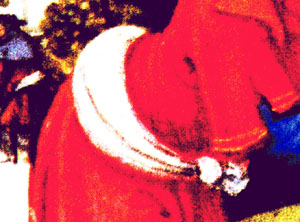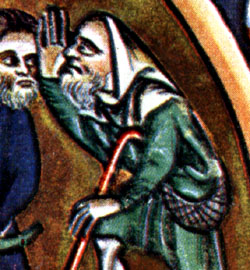



Main Menu - Misc. - Clothing/Textiles - Medieval Wales - Names - Other Medieval - Publications - Harpy Publications
Return to main page
Viewed as a whole, the artifact I'm identifying collectively as a "Shepherds Purse" falls in about four stylistic clusters: the net-purse, the sash-purse, the crescent-shaped purse (occuring with and without netting), and the shaped purse with flap ("flapped purse").




Seen as a group here, I hope that the same two things strike the viewer as have become apparent to me in the course of this study: the overall unified stylistic "gestalt" of the various forms, and yet at the same time their clearly different (and in some cases unrelated) functional origins. That is, while the various forms do not represent a single continuous development (but rather, as I shall propose, a blending and braiding of several strands of development), some overall pressure has led to similarity of shape and style. As I discuss in the section Why Shepherds?, if we believe that these pictures do represent an actual artifact, and actual variations on that artifact, I believe that the stylistic unity is a matter of form following function -- that the features desired in a shepherd's accessory may argue for this shape as an evolutionary goal. In that case, treating the various styles, in some ways, as a single "artifact type" can be considered valid. In the sections following this one, I will be discussing the styles individually, but here I intend to look at the overall pattern of appearance.
The chronology of the appearance of the shepherds purse always has to be considered in light of the availability of sources. For the non-specialist reading English language publications, the focus of the available material will tend to be England, France, and the Low Countries, and in fact for the most part the entire scope of Shepherds Purses can be traced within France as I shall do here.
The earliest example that I have found so far is a net-only purse (or possibly a net-and-cloth purse) in the Paris Psalter ca. 1230. It is difficult to tell from the picture whether this is a true belt-style purse or whether it has a shoulder strap. The item is clearly associated with shepherds, being found in an Annunciation to the Shepherds genre scene.

The net-only style is best illustrated in another Annunciation scene from the Tres Belles Heures (early 15th c.). Here the net clearly appears with no cloth lining, and in one case we appear to be able to see the contents through the net. Here the purse is also clearly dependent from a belt but, from the line of the drape, does not form the belt itself.

Much more commonly, netting appears as an outer layer with an opaque cloth lining. This style is most characteristic of the 15th century, as in this example from the Bedford Hours in an Annunciation scene. It pretty much disappears in the 16th century, with the exception of a couple depictions in the Hours of Henry VIII. The meshes of the netting are nearly always shown "lozenge-wise" (i.e., with corners pointing up-down and horizontally), which corresponds to the orientation that works best in reconstruction for a closed, netted bag. In this particular example, we can see a buckled strap fastening the purse around the waist.

Another major origin of the Shepherds Purse appears to be a sash-like belt -- simply a long, wide piece of fabric tied around the waist (and in the case of the Shepherds Purse, first wound around the contents). In contrast to the netted styles, where we seem to see a chronological development from a simple net bag to a more elaborate combination of netting, straps, and lining, the most "primitive" portrayals of the sash style of purse occur later than the appearance of relatively stylized versions of it. The best representation of what I believe to be the origins of this style appears not in a shepherding context, but in a 16th century painting of Abraham and Hagar, where Hagar and her son Ishmael are setting off into the wilderness, and she carries some bread in a sash knotted loosely around her waist.

In the context of a shepherd, the clearest example of the style is in an early 16th c. sheep-shearing scene, where the knotted ends of the sash are clearly seen, and its thickness strongly suggests rolled-up contents (although not as clearly as some other examples).

The sash group is found throughout the 15th and 16th centuries -- it may also occur earlier, but it can be difficult to distinguish from a sash functioning as a belt. Note that sash-belts with no evidence of a carrying function are quite common in art and not in the least restricted to shepherds.
The crescent-shaped purse is by far the numerically most common style in my data and appears throughout the 15th and 16th centuries. It is characterized by a clear taper from the "contents" portion of the object to the opposite side of the waist. Typically, the depiction is oriented so that the "contents" portion is towards the viewer, so the fastening mechanism is rarely evident. Sometimes there may be a fringe or scalloped edge along the bottom, suggesting there may be a seam there. A typical example of this latter is seen in the late 15th c. Hours of Mary of England.

As mentioned above, this style may occur in combination with netting (or at least a netted appearance). If there is no netting, it is also common for this style to appear in combination with tools or other objects hanging either from the Shepherds Purse itself or from a separate belt. (Hanging tools are not, in general, found with the netted version.) Examples of this type with hanging tools appear to be restricted to the 16th century or very late 15th century. An excellent example of this can be seen in the tapestry La Main Chaude.

The crescent-shaped style is often unclear as to how one accesses the contents. Some examples suggest an evolution from a rolled sash, others perhaps from a tubular bag gathered (by a drawstring?) at one end. In the last stylistic group, access is clearly indicated by a flap (although the flap may be indicated only by a curved line). The flap may not show a fastening method, or it may have a tie (usually two cords emerging from the flap, tied in a single-bow knot) or buttons. An example of the former from the later 15th c. Simon Marmion Hours is shown here.

Like the crescent pouch, 16th century examples of the flapped pouch may be accompanied by hanging implements, often attached to rings that are either stitched onto the upper part of the flap, or are attached to a separate belt. An example of the former can be seen in the tapestry Les Joyeux Bergers.

In summary, we have netted purses, starting with a simple net bag at least as early as the 13th century and appearing commonly as a netted version of the crescent-shaped purse in the 15th century, but largely disappearing by the 16th century. The crescent-shaped purse first shows up in the 14th century, dominates in the 15th century, and continues through the 16th (with rare 17th c. examples) either alone or accompanied by hanging tools. The flapped purse begins appearing around the mid 15th century and continues through the 16th, when it may also occur with hanging tools.
| 13th C. | 14th C. | 15th C. | 16th C. | |
| Netting only | X | X | X | |
| Netting + Crescent | X | X | ||
| Crescent | X | X | X (optional tools) | |
| Flapped | X | X (optional tools) |
Although this appears to show a clear progression of styles, only parts of it are based on enough data for significant confidence. To get a better sense of the numbers, the following table counts individual numbers of pouches (which will skew the numbers in a different way, as multiple pouches within a work will tend to be the same type, so a couple of multi-shepherd works can produce the appearance of a major trend). This doesn't include pouches worn over the shoulder or non-Shepherds Purse styles.
| 13th C. | 14th C. | Early 15th | Mid 15th | Late 15th | Early 16th | Mid 16th | Late 16th | |
| Net only | 1 | 2 | ||||||
| Net + Crescent | 1 | 18 | 7 | 10 | 1 | |||
| Crescent | 14 | 7 | 22 | 15 | 9 | |||
| Crescent + Flap | 22 | 9 | 28 | |||||
| Sash | 1 | 1 | 1 | 3 | 6 |
Previous --------------------------------------------- Main --------------------------------------------- Next
This site belongs to Heather Rose Jones. Contact me regarding anything beyond personal, individual use of this material.
Unless otherwise noted, all contents are copyright by Heather Rose Jones, all rights reserved.